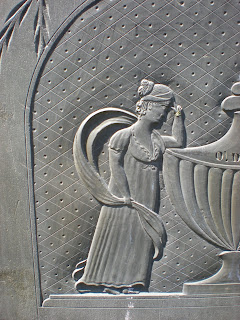In fact, it reminded me immediately of our watercolor mourning pictures of the same era. The stone carving was done for a ship captain’s wife, Polly Mantor, who died in 1817. In addition to the lettering the border treatments, and the weeping willow, the carver set aside an arched vignette near the top of the gravestone for the mourning picture. It shows a classically garbed mourner, who at first appears to be weeping, standing beside (indeed leaning on) a large urn with the inscription “O! Death.”
There are astonishing details here for the medium: the flowing shawl or scarf that curls its way around the mourner; the rendering of her hair and facial features; and the pattern of the background, which resembles a period wallpaper. Looking closely, I also noticed that her left hand is not holding her forehead in the conventional weeping pose, but rather is pointing upward in a gesture seen as a disembodied hand on many of these stones with the saying “Just Beyond.”
I compared this carving to two of watercolors done about the same time, circa 1810-1820, by Eunice Pinney of Connecticut. The first of these, her memorial to herself (that’s another story!) shows the mourning scene iconography that gained popularity in the United States after the death of George Washington in 1799. The second, entitled simply “Two Women,” is not a mourning picture at all, but show the same pattern seen in the background of the carving, only here as a floor covering.
Polly Mantor died at the young age of 31 in 1817. Her husband, Captain Jeremiah Mantor, obviously paid well for this elaborate stone. He outlived her by 44 years, and died in 1861 at the age of 84. In a culture surrounded by death, it appears that the visual means of coping with loss were many and varied, and folk artists were there with both brush and chisel to provide tangible expressions of an all-too-common grief.






Is the figure on the gravestone holding a painted flower in her upturned hand?
ReplyDeleteNo, that's lichen, I think.
ReplyDeleteI just ran across a similar vividly figural and narrative mourning scene on a gravestone in Chester, Vermont a few weekends ago. I'll check to see if I took a picture and send it to you.
ReplyDelete